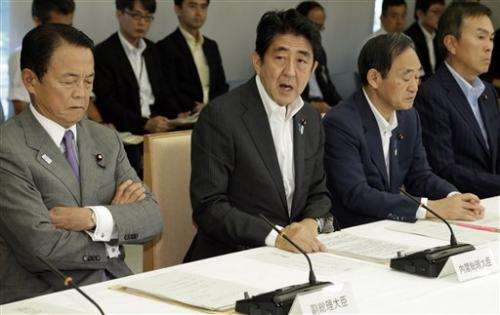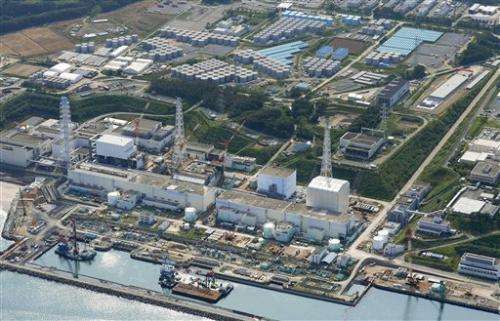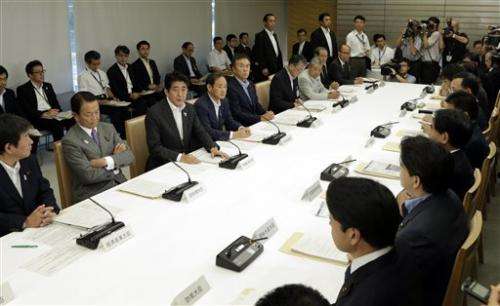Japan to fund ice wall to contain reactor leaks (Update)

The Japanese government announced Tuesday that it will spend $470 million on a subterranean ice wall and other steps in a desperate bid to stop leaks of radioactive water from the crippled Fukushima nuclear plant after repeated failures by the plant's operator.
The decision is widely seen as an attempt to show that the nuclear accident won't be a safety concern just days before the International Olympic Committee chooses among Tokyo, Istanbul and Madrid as the host of the 2020 Olympics.
The Fukushima Dai-ichi plant has been leaking hundreds of tons of contaminated underground water into the sea since shortly after a massive 2011 earthquake and tsunami damaged the complex. Several leaks from tanks storing radioactive water in recent weeks have heightened the sense of crisis that the plant's owner, Tokyo Electric Power Co., isn't able to contain the problem.
"Instead of leaving this up to TEPCO, the government will step forward and take charge," Prime Minister Shinzo Abe said after adopting the outline. "The world is watching if we can properly handle the contaminated water but also the entire decommissioning of the plant."
The government plans to spend an estimated 47 billion yen ($470 million) through the end of March 2015 on two projects—32 billion yen ($320 million) on the ice wall and 15 billion yen ($150 million) on an upgraded water treatment unit that is supposed to remove all radioactive elements except water-soluble tritium—according to energy agency official Tatsuya Shinkawa.
The government, however, is not paying for urgently needed water tanks and other equipment that TEPCO is using to contain leaks. Shinkawa said the funding is limited to "technologically challenging projects" but the government is open to additional help when needed.
The ice wall would freeze the ground to a depth of up to 30 meters (100 feet) through a system of pipes carrying a coolant as cold as minus 40 degrees Celsius (minus 40 Fahrenheit). That would block contaminated water from escaping from the facility's immediate surroundings, as well as keep underground water from entering the reactor and turbine buildings, where much of the radioactive water has collected.
The project, which TEPCO and the government proposed in May, is being tested for feasibility by Japanese construction giant Kajima Corp. and is set for completion by March 2015.

Similar methods have been used to block water from parts of tunnels and subways, but building a 1.4-kilometer (0.9-mile) wall that surrounds four reactor buildings and their related facilities is unprecedented.
An underground ice wall has been used to isolate radioactive waste at the U.S. Department of Energy's former site of the Oak Ridge National Laboratory in Tennessee that produced plutonium, but only for six years, according to the MIT Technology Review magazine.
Some experts are still skeptical about the technology and say the running costs would be a huge burden.
Atsunao Marui, an underground water expert at the National Institute of Advanced Industrial Science and Technology, said a frozen wall could be water-tight but is normally intended for use for a few years and is not proven for long-term use as planned in the outline. The decommissioning process is expected to take about 40 years.
"We still need a few layers of safety backups in case it fails," Marui told The Associated Press. "Plus the frozen wall won't be ready for another two years, which means contaminated water would continue to leak out."
Marui said additional measures should be taken to stop contaminated water from traveling under the seabed during that time and leaking further out at sea.
TEPCO has been pumping water into the wrecked reactors to cool nuclear fuel that melted when the March 2011 earthquake and tsunami knocked out the plant's power and cooling systems. The utility has built more than 1,000 tanks holding 335,000 tons of contaminated water at the plant, and the amount grows by 400 tons daily. Some tanks have sprung leaks, spilling contaminated water onto the ground.

After spending on the ice wall, the remainder of the public funding—15 billion yen until March 2015—will go to the development and production of a water treatment unit that can treat larger amounts of contaminated water more thoroughly than an existing machine, which is under repair after corrosion was found during a test run.
Nuclear Regulation Authority Chairman Shunichi Tanaka has repeatedly said that the contaminated water cannot be stored in tanks forever and eventually must be released into the sea after being fully processed and diluted, but only with local consent.
Other measures include replacing rubber-seamed storage tanks with more durable welded tanks as quickly as possible, and pumping out untainted underground water further inland for release into the sea to reduce the total amount of water flowing into the plant site. About 1,000 tons of underground water runs into the complex every day.
TEPCO is also constructing an offshore wall of steel panels to keep contaminants from spreading further into the sea. The utility says radioactive elements have mostly remained near the embankment inside the bay, but experts have reported offshore "hot spots" of sediments contaminated with high levels of cesium.
The leaks came as Tokyo headed into the final days of the contest to host the 2020 Summer Olympics. With anti-government demonstrations plaguing Istanbul's bid and a recession and high Spanish unemployment hanging over Madrid's candidacy, Tokyo is pushing its bid as the safe choice in uncertain times.
The IOC is to select the 2020 host on Sept. 7 in Buenos Aires, Argentina.
© 2013 The Associated Press. All rights reserved.





















